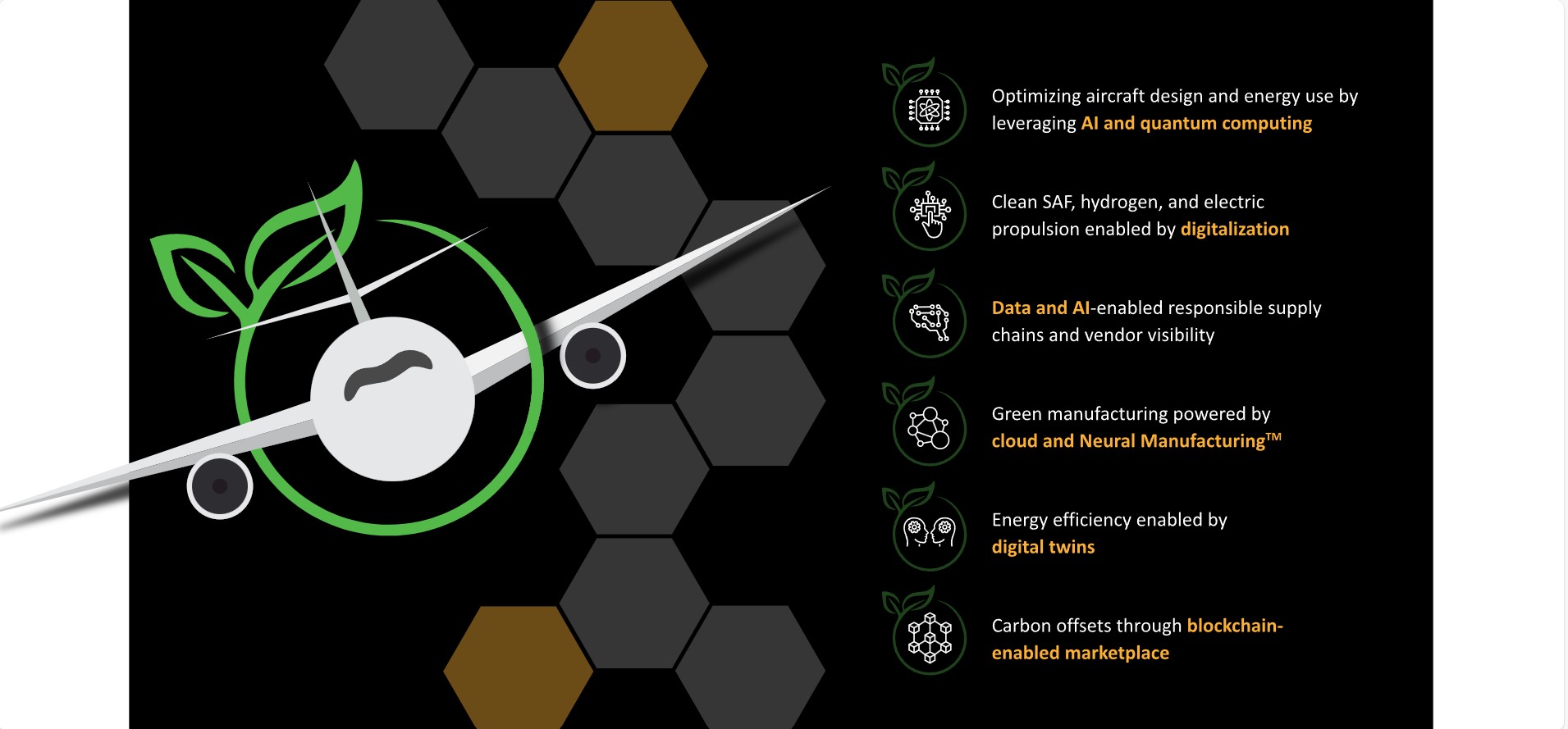Industry
Solution
HIGHLIGHTS
- A successful net-zero transition for the aerospace industry will need not just reducing emissions, but also reinforcing the aspects of economics, resilience, and industrial competitiveness.
- Hard-tech scientific advances as well as emerging digital solutions are what aerospace manufacturers will have to focus on to achieve the industry’s 2050 net zero goal.
- The industry will have to dramatically increase the scale and speed of introducing sustainable solutions into the mainstream.
The net zero journey
While the world has made meaningful progress on the Paris Agreement goals, global CO2 emissions remain unacceptably high.
For its part, the aviation industry, which accounts for about 2%–3% of global CO2 emissions, has made an ambitious pledge to achieve net zero carbon by 2050. However, even a conservative estimate of passenger traffic forecasts nearly doubling of revenue passenger miles (RPM) during the same time, making it doubly more challenging to meet those targets. Many technical measures, such as using sustainable aviation fuel (SAF), electrification technologies, and improving infrastructure and operational efficiencies, can go a long way in containing emissions and meeting the net zero goal.
The moonshot – a multi-faceted problem at hand
The journey to net zero emission for the aerospace industry is riddled with challenges.
The industry is one of the most difficult ones to decarbonize due to lack of technological readiness levels, regulatory and safety considerations, and economic viability factors. Currently, there is no other fuel technology that can provide the energy-to-weight ratio (specific energy) that fossil fuel can provide and is as economical. But burning jet fuel emits carbon and other emissions. While SAFs can reduce emissions by about 70%-80%, high production costs and limited supply have hindered its adoption. SAF production is expected to triple to about 1.9 billion liters in 2024, from 600 million liters last year, though it would still account for 0.53% of aviation’s fuel need. So, the goal to achieve carbon net zero by 2050 is nothing less than a moonshot.
The aerospace industry is constrained in its actions due to three important reasons:
- Aircraft have a long useful life. Aircraft remain in service for about 20 to 30 years, and as a result, the fleet renewal process spans over decades. Maximizing the useful life of an aircraft though indirectly reduces the recycling burden as well.
- Aircraft have lengthy production cycles. Due to the stringent certification requirements and safety standards, aircraft are mandated to go through rigorous product development and testing. So, the associated certification times can take up to a decade, making it unable to always implement the latest technological advancements immediately.
- Aircraft use a lot of energy. Aircraft move passengers and goods faster than any other mode of transport. Moving passengers at over 600 miles per hour, and that too at an altitude of nearly seven miles above the ground, requires a considerable amount of energy. From a technology perspective, currently, very few energy storage solutions can provide the energy-to-weight ratio (specific energy) that fossil fuels can.
Navigating the net zero conundrum
The aerospace industry will have to embrace a variety of sustainable solutions at speed and scale.
It does not yet have all the technologies to achieve the net zero goal by 2050. There are several deep-tech scientific advances that are still being worked on, along with enablement from digital technologies. Moreover, aviation's climate footprint extends beyond just CO2. Considering the non-CO2 effects, such as contrails and nitrous oxides, aviation's total emission footprint may be >2x of CO2 alone. To decarbonize itself in the given time frame, the industry will need to dramatically increase the scale and speed of introducing sustainable solutions to the mainstream.
There are six broad areas that the industry needs to focus on to reach the net zero goals.
Reducing aircraft energy use
- The aviation industry has been working on more efficient aircrafts and engine designs for many decades. NASA has been working with aircraft OEMs to develop a truss-braced wing design that could help reduce fuel consumption by almost 10% per flight or adding wingtip devices to an aircraft – this is estimated to reduce fuel consumption by nearly 4%. In addition, artificial intelligence (AI)-enabled quantum computing can be leveraged to expedite new design simulations and materials development. That will speed up the design cycle time, reduce weight, and enable more sustainable aircraft designs.
- Optimizing flight paths, reducing taxi times, and enhancing flight operational efficiency to minimize fuel consumption are some of the benefits for airlines as well as the environment. We believe AI and generative AI will become pervasive in achieving those goals. For example, landings using a continuous descent into an airport are estimated to save almost 150 kg of CO2 per commercial flight and shortening flight time by a minute can potentially save over 60 kg of CO2 on a commercial fligh.
Changing the fuel – To achieve and sustain net zero emissions, jet fuel-based propulsion must be replaced with true-zero alternatives. SAF, hydrogen- based propulsion, and electric propulsion are three promising solutions, but they are still in the realm of deep-tech scientific development. Even though the role of a digital technology service provider here may not be obvious, digital technologies are an important element in enabling their net-zero journey. This may include, for example, digital enablers for electrification of on-ground mobility, portable charging solutions, lifecycle assessment of hydrogen fuel, and modelling for choice of fuel performance.
Embracing green manufacturing – Incorporating sustainable materials, such as composites and recycled metals, into the manufacturing process of aircraft components is another way to improve circularity. Moreover, we see opportunities in additive manufacturing (3D printing) to improve design and reduce material waste. Other digital technologies such as 5G- enabled smart and connected factories, blockchain for supply chain traceability, and AI-driven overall equipment effectiveness (OEE) can also improve operational and sustainability outcomes for component makers.
Deploying responsible supply chains – In addition to implementing energy-efficient practices in manufacturing facilities and operational processes, the aerospace industry also needs to reduce Scope 1 and 2 emissions. Ensuring that supply chains adhere to sustainability standards is also critical from the Scope 3 emissions standpoint. Scope 3 emissions are indirect emissions that occur in the value chain of a company, including both upstream and downstream emissions. Digital enablers, such as AI and machine learning (ML)-powered sustainability solutions, that deliver comprehensive insights and recommendations across the value chain, can provide greater visibility and accountability.
Ensuring energy efficiency – Manufacturing operations consume a significant amount of energy not only for the machinery and the equipment used, but also for heating, ventilation, and cooling of the facilities. The US Energy Information Administration estimated that in 2022, the industrial sector accounted for 35% of total U.S. end-use energy consumption. Digital technologies such as AI and ML, cloud, and edge-based energy use and monitoring, can be leveraged to optimize energy footprint as well as encourage greater use of renewable energy sources. For example, an integrated digital twin setup with AI and ML-based algorithm can provide a holistic energy view, that will help manufacturers take informed decisions through predictive process analytics. It will also improve the return on investment (RoI) through significant reduction in energy usage across operations while also lowering climate footprint.
Re-capturing unavoidable carbon dioxide – Many sustainable replacements of conventional aviation fuel will neutralize the in-flight emissions, but these will still have a residual carbon footprint associated with their manufacture. CO2 emitted from the production of near carbon-neutral fuels as well as manufacturing hardware will have to be mitigated by atmospheric carbon capture and credible carbon offsets. As emissions trading requirements and regulations become more stringent, we believe blockchain will emerge as one of the underlying technologies for credible and verifiable carbon offsets marketplace. For example, an ecosystem-wide blockchain-enabled platform to allow simultaneous settlement of carbon credits, with immediate transfer of ownership upon payment, can be a potential digital solution.
The road ahead
Timely technological advancements are the panacea to achieve the net zero goal for the aerospace industry.
Achieving the goals, however, will also require collective action on other factors. A successful net zero transition for the industry will require, besides technological advancements in achieving emissions reduction, mutually reinforcing aspects of economics, resilience, and industrial competitiveness for the industry. It will also need the continued collaboration between the industry and academia, public-private partnerships, and government policy framework. That will help to keep up the momentum, ensure steady funding and progress towards the net zero moonshot.








